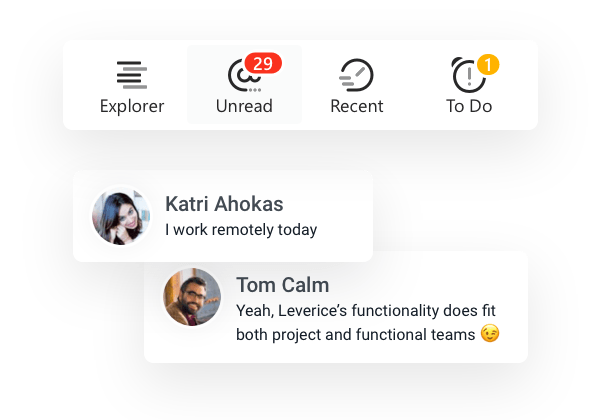Drinking from a firehose gets old fast, but that’s what most teams with structureless team messaging find themselves doing. You know the feeling.
If you and your team have channel flooding, you’ve basically got two choices:
- Drink from the firehose in an effort to keep up. Monitor that endless flow of conversation. Stay hypervigilant. React to every ding and notification. Because if you don’t: you know that critical message will get lost in the flood and scroll up into the abyss beyond your computer screen’s horizon.
- Take a break. Step away from your computer for a few hours. Go have a nice meal, enjoy the sunshine, spend time with a relative or friend. This approach is good for your mental health, but since your team messaging is a structureless firehose, prepare to come back to a cannon blast of jumbled unread messages to the face.
It doesn’t have to be like this. There’s a third way, and it’s better.
Threads Add Topical Integrity to Your Team Messaging
The channel firehose effect is easy to stop, and it starts by adding a layer of logic and structure to your team messaging. Instead of discussing fish, birds and bears in a big bucket of a channel called “Animals” — break it out.
Let’s start by creating a sub-channel called “Mammals”.
Then break your topics down even further, and magic starts to happen for both writers and recipients of your team messages. Here’s how:
Now if I need to post a message about grizzly bears, I’ll put it onto the shelf dedicated to that microtopic: /Animals /Mammals /Bears /Grizzlies. Result? It doesn’t get lost in a flood of messages in a catchall channel called Animals. Everyone who needs to pay attention to the grizzly bears topic will see it, whether they’re online now or coming back to their computer in a few hours. I as the writer don’t need to double up and also send this important message via email, since I know it won’t get washed away in a channel flood.
On the other side, my teammates know they won’t miss out. A colleague who works on the Grizzly Bears topic can step away, focus on his work, do anything else for hours (or even longer) and know that he won’t miss an important message about grizzlies by not being hypervigilant to every ding and notification from his teams threaded conversations.
If on the other hand I’m only concerned about fish and don’t work with pandas, black bears or grizzlies, I can unsubscribe from the /Animals/Mammals branch without leaving the Animals subject altogether.
When your team messaging stops being like confetti, your workday stops feeling like confetti too.
Add Asynchronicity to Your Team Messaging
Threading, and especially deep threading of the sort we developed at Leverice, works wonders for distributed teams. It adds an element of asynchronicity to team messaging that reduces the strain of always-on hypervigilance.
What does that mean?
Almost all team messaging platforms (and the way most people traditionally think about team messaging) are synchronous and person-centric. Instinctively, most start their messages by thinking “Who should I ping?” You send a message, and the other person must process the info and respond immediately, or almost immediately. You snooze, you lose. Result: FOMO, stress and distraction on all sides.
Synchronous communications are important for fire alarms, but not everything is a fire alarm. Realtime rapidfire communications can hurt team productivity more than they help. Every interruption has an opportunity cost, because while your attention may drift to that notification ding for only a second, it can take minutes to refocus on your task at hand. In synchronous messaging, a premium is placed on connectedness (instant availability) as opposed to productivity and results.
Asynchronous messaging is when you send a message without expecting an immediate response. Teammates respond at their own pace, and so do you. The messaging shifts to a topic-centric focus: “What am I talking about?” rather than “Who do I want to ping?”
Making a shift to topic-centric asynchronous team trees messaging can require a transition inhabits, processes, and digital tools to move to a more appropriate platform, but it pays off big time. If urgent matters require immediate response, consider using other channels of communication, but be selective about what messages you route that way. If everything’s treated like a fire alarm, people will stop hearing the alarm.
Leverice is messaging-as-a-platform that takes aim at information overload.

